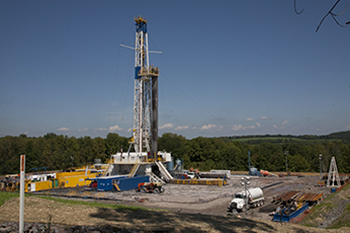Submitted by PRWatch Editors on
 When the Environmental Protection Agency abandoned its multimillion-dollar investigation, which found strong evidence of fracking contamination of water resources in Wyoming in June, industry groups cheered, and environmentalists fumed.
When the Environmental Protection Agency abandoned its multimillion-dollar investigation, which found strong evidence of fracking contamination of water resources in Wyoming in June, industry groups cheered, and environmentalists fumed.
Thousands of Americans fearing fracking chemical contamination of their wells were abandoned. "If there is any question whatsoever about the safety of fracking and its effects on drinking water supplies, the EPA should make it a top priority to investigate the matter fully," said Wenonah Hauter, of Food and Water Watch.
The EPA will turn over control of the study and its data to Wyoming's tiny environmental agency and it will become an advisor to the state, on par with fracking firm Encana Oil & Gas, Inc. The EPA's retreat on Wyoming provides a cautionary tale on how easy it is for industry pressure to trump science in the agency that is now undertaking a much larger study on the same topic slated to be finalized shortly before the end of Obama's second term.
Frack Study Hits an Industry Wall
At one point the EPA appeared to be moving aggressively to figure out if fracking was connected to mounting complaints of water pollution and health problems near well sites nationwide. The EPA also launched scientific studies in Texas, Wyoming and Pennsylvania. When the EPA's probe of the issues in Pavillion, Wyoming were published they came under intense and sustained industry pressure, a final report was never issued and the agency appears to have abandoned the task of generating scientific conclusions from their own hard-won data.
This controversy and the EPA's retreat are detailed in an excellent investigative piece by Propublica. Below we excerpt a section on the Wyoming fiasco as it illustrates how industry is ready, willing and able to bury scientific findings it disagrees with.
The EPA probe in Pavillion began in 2008 with the aim of determining whether the town's water was safe to drink. The area was first drilled in 1960 and had been the site of extensive natural gas development since the 1990's. Starting at about the same time, residents had complained of physical ailments and said their drinking water was black and tasted of chemicals.
The EPA conducted four rounds of sampling, first testing the water from more than 40 homes and later drilling two deep wells to test water from layers of earth that chemicals from farming and old oil and gas waste pits were unlikely to reach.
The sampling revealed oil, methane, arsenic, and metals including copper and vanadium -- as well as other compounds -- in shallow water wells. It also detected a trace of an obscure compound linked to materials used in fracking, called 2-butoxyethanol phosphate (2-BEp).
The deep-well tests showed benzene, at 50 times the level that is considered safe for people, as well as phenols -- another dangerous human carcinogen -- acetone, toluene, naphthalene and traces of diesel fuel, which seemed to show that man-made pollutants had found their way deep into the cracks of the earth. In all, EPA detected 13 different compounds in the deep aquifer that it said were often used with hydraulic fracturing processes, including 2-butoxyethanol, a close relation to the 2-BEp found near the surface.
The agency issued a draft report in 2011 stating that while some of the pollution in the shallow water wells was likely the result of seepage from old waste pits nearby, the array of chemicals found in the deep test wells was "the result of direct mixing of hydraulic fracturing fluids with ground water in the Pavillion gas field."
The report triggered a hailstorm of criticism not only from the drilling industry, but from state oil and gas regulators, who disagreed with the EPA's interpretation of its data. They raised serious questions about the EPA's methodology and the materials they used, postulating that contaminants found in deep-well samples could have been put there by the agency itself in the testing process.
In response, the EPA agreed to more testing and repeatedly extended the comment period on its study, delaying the peer review process.
Agency officials insist their data was correct, but the EPA's decision to withdraw from Pavillion means the peer-review process won't go forward and the findings in the draft report will never become final.
"We stand by what our data said," an EPA spokesperson told ProPublica after the June 20 announcement, "but I do think there is a difference between data and conclusions."
Wyoming officials say they will launch another year-long investigation to reach their own conclusions about Pavillion's water.
Meanwhile, local residents remain suspended in a strange limbo.
While controversy has swirled around the deep well test results -- and critics have hailed the agency's retreat as an admission that it could not defend its science -- the shallow well contamination and waste pits have been all but forgotten.
The Agency for Toxic Substances and Disease Registry, the federal government's main agency for evaluating health risk from pollution, has advised Pavillion residents not to bathe, cook with, or drink the water flowing from their taps. Some have reported worsening health conditions they suspect are related to the pollution. They are being provided temporary drinking water from the state in large cisterns.
The Clock Is Ticking on the EPA
The EPA is planning a national study on hydraulic fracturing with case studies in five additional states. The final report, after public comment in 2014, is slated for 2016, the last year of the Obama administration.
Without sustained public pressure on the EPA, high-cost, high-quality scientific research of the type only an independent federal agency can provide may never see the light of day.


Comments
Anonymous replied on Permalink
EPA Fracking Koch Brothers
Ryan Riddle replied on Permalink
Fracking